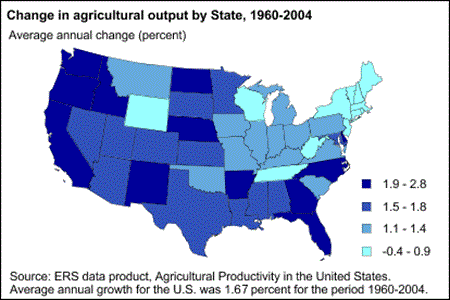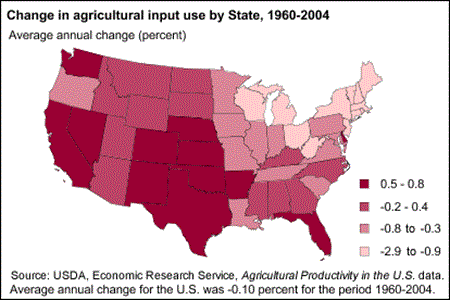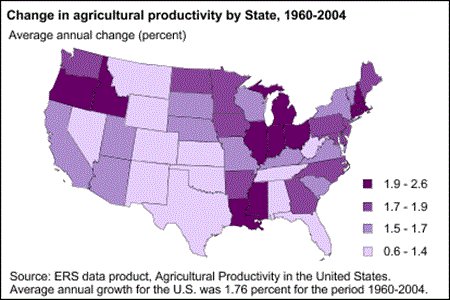Productivity Growth in U.S. Agriculture (1948–2021)
Note: Find the full citations for papers mentioned below in References. Find tables referenced below in the main file listing page.
The U.S. Department of Agriculture (USDA) has been monitoring agriculture's productivity performance for decades. In fact, in 1960, USDA became the first agency to introduce multifactor productivity measurement into the Federal statistical program. Today, the Department's Economic Research Service (ERS) routinely publishes total factor productivity (TFP) measures based on a sophisticated system of farm production accounts. USDA-ERS's TFP model is based on the transcendental logarithmic (translog) transformation frontier; annual TFP growth rates are measured using the Törnqvist-Thiel Index number approach. USDA-ERS's TFP measure relates the growth rates of multiple outputs to the cost-share weighted growth rates of labor, capital, and intermediate inputs. (See Shumway et al. (2017) and Ball et al. (2016) for more details regarding the background and a complete description of the USDA model.)
The applied USDA-ERS model is quite detailed. The changing demographic character of the agricultural workforce is used to build a quality-adjusted index of labor input. Similarly, asset-specific details underlie the measures of capital inputs. The index of land input, for example, is constructed by aggregating county-level data. The contributions of feed, seed, energy, agricultural chemicals, purchased services, and other materials are captured in the index of intermediate inputs. An important innovation is the use of hedonic price indices in constructing measures of fertilizer, pesticide, and purchased contract labor services inputs.
The result is a time series of total factor productivity indices for the aggregate farm sector spanning the period 1948 to 2021 (see table 1), along with price and quantity indices for 10 outputs and 12 inputs (see table 1a). State-specific measures are available for the 1960–2004 period. The State series provides estimates of both the growth and relative levels of total factor productivity (see tables 3–23).
National Agricultural Productivity
Output growth derives from growth in the use of inputs (capital, land, labor, and intermediate goods) and TFP. Input growth has been the main source of economic growth for the U.S. economy as a whole and for most sectors, but the agricultural sector seems to be an exception (Jorgenson et al. 2014).
According to ERS estimates, while total farm output nearly tripled between 1948 and 2021, growing at an average annual rate of 1.46 percent, total input use declined slightly, at a annual average rate of -0.03 percent over this period. A notable reduction in inputs was seen in the 2019–2021 subperiod, at -3.35 percent per year on average (see the chart in the Summary of Recent Findings).
The composition of inputs has also changed markedly over time, shifting away from labor and land toward machinery and intermediate inputs—including energy, agricultural chemicals, purchased services, and other materials (see table 1). Over the 1948 to 2021 period, labor and land inputs declined by 76 and 28 percent, respectively, while intermediate inputs grew by 109 percent.
TFP growth measures output growth that cannot be explained by growth in inputs, such as innovations in onfarm tasks, changes in the organization and structure of the farm sector (O’Donoghue et al. 2011; Macdonald et al. 2016), improvements in animal and crop genetics, or other embodied and disembodied technical changes. Between 1948 and 2021, farm output grew at 1.46 percent per year on average. With aggregate inputs (including land, labor, capital, and intermediate inputs) declining by -0.03 percent per year on average, total factor productivity—growing at 1.49 percent per year on average over 1948–2021—allowed farm output to grow 190 percent above its 1948 level.
Long-term TFP growth is driven mainly by technical change, which is fueled by research and development (R&D) investment from public and private sectors (Alston et al. 2010; Huffman and Evenson, 2006; Fuglie and Heisey 2007; Plastina and Fulginiti, 2012; and Wang et al. 2013). Long-term TFP growth can also be enhanced by public infrastructure, extension, and technology spillover from other sectors or neighboring regions (Alston et al. 2010; Huffman and Evenson, 2006; and Wang et al. 2012). Yet, in the short term, estimated agricultural TFP growth can fluctuate considerably from year to year, largely in response to transitory events (such as bad weather (Liang et al. 2017; Ortiz-Bobea et al., 2018; Wang et al. 2019) and pest outbreaks) or to changes in input use affected by macroeconomic activities or short-term policies (Wang and McPhail 2014). Eventually, TFP growth will return to its long-term trend following these temporary shocks.
Sources of Agricultural Output Growth
In addition to long-term trends, ERS also examines the sources of agricultural output growth—apportioning increases in output among changes in inputs (both quantities and quality/composition) and TFP—for the 1948–2021 period and 12 subperiods. The subperiods are not chosen arbitrarily, but are measured from cyclical peak to peak in aggregate economic activity (National Bureau of Economic Research, 2023). Data reported for each subperiod are average annual growth rates, so the different lengths of the subperiods do not affect comparisons across subperiods.
Applying the USDA model, output growth equals the sum of the contributions of labor, capital, and materials inputs and TFP growth. The contribution of each input equals the product of the input's growth rate and its respective share of total costs.
Typically, input growth is the dominant source of economic growth for the aggregate economy and for each of its producing sectors. Agriculture turns out to be one of the few exceptions, where productivity growth dominates input growth (Jorgenson et al. 2014). According to USDA estimates, the singularly important role of productivity growth in agriculture is made all the more remarkable by the dramatic contraction in labor input in the sector, a pattern that persists through every subperiod, with the exception of 2007–2019. Over the full 1948–2021 period, labor input declined at an average annual rate of -1.93 percent. When weighted by its share of total costs, the contraction in labor input contributes an annual average -0.42 percentage point per year to output growth over the full period.
Note: The subperiods are measured from cyclical peak to peak in aggregate economic activity dated by the National Bureau of Economic Research.
| 1948–2021 | 1948–1953 | 1953–1957 | 1957–1960 | 1960–1969 | 1969–1973 | 1973–1979 | 1979–1981 | 1981–1990 | 1990–2000 | 2000–2007 | 2007–2019 | 2019–2021 | ||
|---|---|---|---|---|---|---|---|---|---|---|---|---|---|---|
| Output growth | 1.46 | 0.98 | 0.54 | 3.75 | 1.56 | 2.54 | 2.45 | 2.57 | 0.80 | 1.80 | 0.90 | 0.68 | 2.23 | |
| Sources of growth | ||||||||||||||
| Input growth | -0.03 | 0.67 | -0.01 | 0.34 | -0.04 | 0.49 | 1.55 | -1.25 | -1.28 | 0.30 | 0.08 | -0.02 | -3.35 | |
| Labor | -0.42 | -0.83 | -1.11 | -0.88 | -0.79 | -0.41 | -0.19 | -0.23 | -0.45 | -0.23 | -0.37 | 0.38 | -1.65 | |
| Capital | -0.07 | 0.57 | 0.00 | -0.12 | 0.06 | -0.15 | 0.30 | 0.04 | -0.76 | -0.22 | -0.05 | 0.06 | -0.10 | |
| Materials | 0.46 | 0.92 | 1.10 | 1.34 | 0.68 | 1.06 | 1.44 | -1.05 | -0.07 | 0.75 | 0.50 | -0.46 | -1.60 | |
| Total factor productivity | 1.49 | 0.31 | 0.55 | 3.41 | 1.60 | 2.04 | 0.90 | 3.82 | 2.08 | 1.49 | 0.82 | 0.70 | 5.57 | |
| Input growth decomposition | ||||||||||||||
| Labor | -0.42 | -0.83 | -1.11 | -0.88 | -0.79 | -0.41 | -0.19 | -0.23 | -0.45 | -0.23 | -0.37 | 0.38 | -1.65 | |
| Hours | -0.53 | -1.06 | -1.24 | -0.92 | -1.08 | -0.46 | -0.21 | -0.20 | -0.52 | -0.40 | -0.40 | -0.20 | 0.07 | |
| Quality | 0.11 | 0.23 | 0.12 | 0.04 | 0.29 | 0.05 | 0.01 | -0.03 | 0.07 | 0.18 | 0.02 | 0.58 | -1.72 | |
| Capital | -0.07 | 0.57 | 0.00 | -0.12 | 0.06 | -0.15 | 0.30 | 0.04 | -0.76 | -0.22 | -0.05 | 0.06 | -0.10 | |
| Stocks | -0.10 | 0.19 | -0.18 | -0.20 | -0.12 | -0.36 | 0.14 | -0.13 | -0.34 | -0.09 | -0.13 | -0.03 | -0.07 | |
| Quality | 0.04 | 0.37 | 0.18 | 0.08 | 0.18 | 0.21 | 0.16 | 0.17 | -0.42 | -0.13 | 0.08 | 0.09 | -0.03 | |
| Materials | 0.46 | 0.92 | 1.10 | 1.34 | 0.68 | 1.06 | 1.44 | -1.05 | -0.07 | 0.75 | 0.50 | -0.46 | -1.60 | |
| Quantity | 0.43 | 1.04 | 0.90 | 1.24 | 0.63 | 1.08 | 1.55 | -1.35 | -0.20 | 0.76 | 0.44 | -0.50 | -1.62 | |
| Quality | 0.04 | -0.12 | 0.20 | 0.10 | 0.05 | -0.02 | -0.12 | 0.30 | 0.13 | -0.02 | 0.06 | 0.04 | 0.02 | |
| Source: USDA, Economic Research Service, Agricultural Productivity in the U.S. data product, updated January 2024. | ||||||||||||||
Capital input in the sector exhibits a different history. Its contribution to output growth alternates between positive and negative over the 1948–2021 period. On average, its negative average growth rate contributes an annual -0.07 percentage point to output growth, mostly seen in the decline in land use. Over the full period, land use declined by 28 percent, at -0.45 percent per year on average.
The negative contributions of both labor and capital are all the more notable given the positive contributions offered through improvements in both labor and capital quality—the changing demographic characteristics of the agricultural labor force composition, and the shifting types of capital assets in total capital stocks. As shown in the above table, farms have shifted to higher-quality labor (working primarily through a more highly-educated workforce (Wang et al., 2022)).
To account for changes in the quality and composition of agricultural family and hired labor, labor hours worked are cross-classified by sex, employment class, age, and education. Average hourly wages of each cross-classification are used to indicate the marginal productivity of each type of worker. If the composition of the workforce changes to include a higher proportion of more highly-paid workers, it then reflects an improvement in the average quality of the farm labor force. Analysis of the changing composition of hours over the 1948–2021 period reveals that the decline in labor hours was coincident with an increase in the proportion of more highly-educated workers. This was sufficient to offset the negative effects of the changing sex, class, and age composition of hours and results in the persistent pattern of improving labor quality throughout the full 1948–2021 period. Increased labor quality made a positive contribution to output growth in 10 of the 12 subperiods, averaging 0.11 percentage points per year, about 8 percent of annual agricultural output growth.
While the changes from three capital subtypes (excluding land)—durable equipment, service buildings, and inventory—made positive contributions to output growth in 9 of 12 subperiods (Wang 2019), the persistent shrinking use of farm land has resulted in a negative contribution to output growth from overall capital growth (including land) at -0.07 percentage points per year over the full 1948–2021 period.
Intermediate inputs' contribution was positive in 8 of the 12 subperiods, and averaged a positive rate of 0.46 percent per year over 1948–2021. Though large, this positive contribution just offsets the negative contributions through labor and capital. Over 1948–2021, the net contribution of all inputs was -0.03 percentage points per year, leaving responsibility for the positive growth in farm sector output to productivity growth in all subperiods.
Examining table 1 (see the main file listing page) makes clear that the 1973–1979 period is an outlier. While output, labor, and capital growth rates did not deviate much from trend, intermediate inputs exhibited positive growth at a rate far in excess of the incremental growth in output, accounting single-handedly for the measured decline in TFP growth. This anomaly appears to be related to rapid growth in export demand during this subperiod, which resulted in both the increased consumption of intermediate inputs as well as a withdrawal of farm goods from inventory. Both factors led to a reduction in productivity growth (see Wang et al. 2015 for further discussion).
The early 2000s saw the emergence of biofuels as a major source of demand for grains and oilseeds. Corn used in ethanol production in 2007 accounted for roughly one-quarter of total corn production, for example. The land area planted to corn increased some 15 million acres between 2006 and 2007, which could have resulted in the cultivation of more marginal lands. Consumption of agricultural chemicals (i.e., fertilizer and pesticides) increased more than 10 percent, yet yields per acre were largely unchanged during the period.
In spite of these anomalous subperiods, over the 1948–2021 period, TFP grew an average of 1.49 percent annually. Cumulated over the full 74-year period, this average annual rate (compounded annually) implies that farm sector productivity in 2021 was nearly 3 times its 1948 level. Given the less-than-one-percent annual increase in total input growth between 1948 and 2021, productivity growth caused agricultural output to grow in every subperiod so that by 2021, farm output was 2.9 times its level in 1948.
State Agricultural Productivity
Note that updates of the State-level statistics are suspended.
A national measure of productivity growth for the aggregate farm sector provides a useful summary statistic indicating how economic welfare is being advanced through productivity gains in agriculture, but it may mask important State-specific or regional trends. For this reason, USDA has constructed estimates of the growth and relative levels of productivity for the 48 contiguous States for the 1960–2004 period (estimates are not made for Alaska and Hawaii as some major data are not available for the entire period). These indices, expressed relative to the level of TFP in Alabama in 1996, are presented in table 19 along with their percentage rates of growth. In tables 20, 21, and 22, we rank the States by their level and growth of farm output, input use, and TFP, in 1960 and 2004.
One remarkable similarity exists across all States for the full 1960–2004 period. Every State exhibited a positive and generally substantial average annual rate of TFP growth. There is considerable variance, however. The median TFP growth rate over the 1960–2004 period was 1.67 percent per year. However, 9 of the 48 States had productivity growth rates averaging more than 2 percent per year. Only Oklahoma and Wyoming had average annual rates of growth less than 1 percent per year. The reported average annual rates of growth ranged from 0.58 percent for Oklahoma to 2.58 percent for Oregon (see maps below). Accumulated over the entire 45-year period, productivity growth in Oklahoma was responsible for only a 30-percent increase in that State's output. Over the same period, TFP growth in Oregon resulted in a 319-percent increase in that State's agricultural output. A key economic question is whether States with lower levels of productivity tend to grow faster than the technology leaders: are there forces (e.g., the diffusion of technical knowledge from the leading States to the more backward ones) that lead to convergence over time in the levels of productivity (see Ball et al. 2014 for more information).




